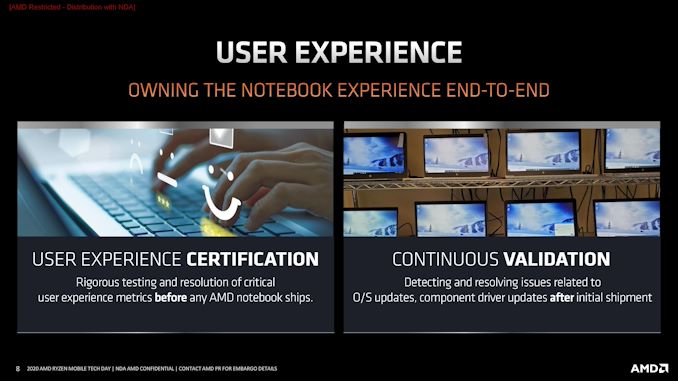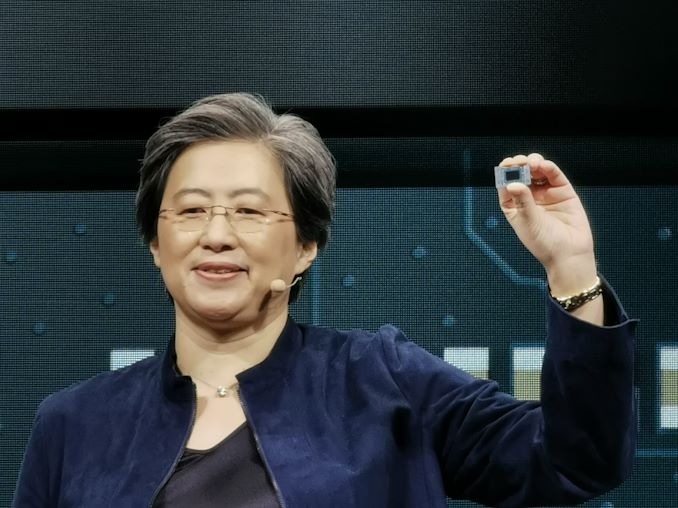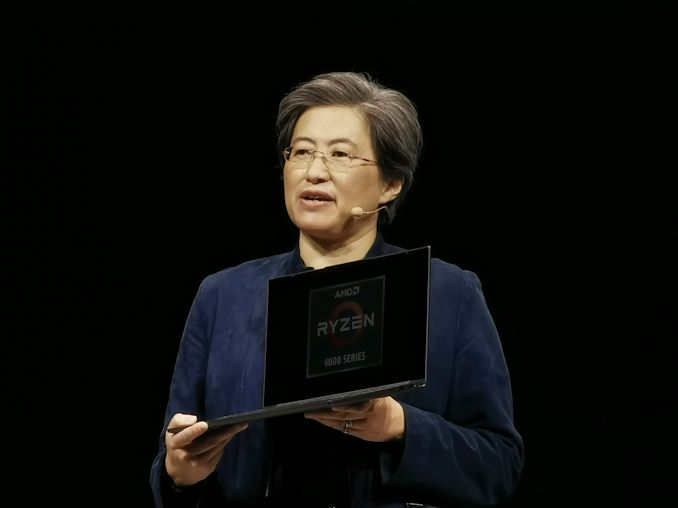AMD Details Renoir: The Ryzen Mobile 4000 Series 7nm APU Uncovered
by Dr. Ian Cutress on March 16, 2020 11:00 AM ESTThe Special HS Processors
As mentioned, at the top end of the new Ryzen Mobile 4000 list are the HS processors, offering almost exactly the same specification as the 45 W H-series processors, but at 35 W. AMD has marked these as special processors, not available to every OEM, because they fall under AMD’s new cooperative design and continuous validation programs.
In order to be able to use a HS processor, an OEM must work with AMD on the design. This is similar to what Intel does – ensure that the OEM partner gets the best from the hardware, and try and assist as to what design decisions the hardware was built for. Ultimately the product that comes out should be one that shows off the best of the hardware and gives the best user experience. On top of this, AMD has a list of ‘assured components’, validated to work against the new processors, and has created two continuous validation labs.
These labs, one in Austin and one in Shanghai, take the systems and pre-test all the new drivers and vendor software on them before they are released to the public. This is to ensure that the system is in no way compromised in performance, power, or thermals as a result of the update (to ensure that a company doesn’t completely mess with the power profile after it launches through a BIOS update or similar). AMD didn’t state how long its continuous validation program will run after the product is shipped, though I should think that at least 12-18 months should be plausible.
If the OEM does all this, and AMD agrees, then the product can use one of the HS processors.
(Note, the normal 45 W processors can be run in a 35 W mode, but just doing that doesn’t mean you can call it a HS. No doubt some third-tier OEM might try…)
The first HS-class system on the market will be the ASUS Zephyrus G14, and we learned in January that ASUS’s design has an exclusive for six months from launch. We’re expecting the G14 to hit the market in Q2, even with the current state of production, so we’ll see more HS models later in the year.
Conclusions
Ultimately today was the day that AMD was going to lift the embargo on Ryzen Mobile 4000 reviews, with the systems that AMD and its partners have provided. Due to the current ongoing issues around the world, those technical reviews of the systems will have to wait a few weeks while production is being ironed out. But for now we have a good grasp as to what AMD has pushing into the new processors coming out later this year.
Regular readers of AnandTech may remember back in 2016 I wrote a very long piece about AMD’s laptop strategy, where I tested five laptops from OEMs that were using AMD’s latest Carrizo APU at the time. The conclusions to that review were three fold: AMD was shooting itself in the foot by providing a platform that allowed its partners to be cheap; the OEM partners were being cheap by giving the hardware 13x7 screens, poor storage, poor trackpads and such because that’s all the customers seemed to want; and the customers were continually asking for cheaper systems, then getting frustrated with the poor user experience, ultimately blaming AMD rather than the OEM. It was a vicious cycle that required someone to break it.
Normally for these launches, a company will create a reference design for its partners to work with. AMD for years was creating these dull $500-$700 reference designs, which ultimately led to the paragraph above. We pled for generations for AMD to make a halo reference design, something ultraportable for $1500. For Renoir, given the reasonable performance uplift from the previous generation, the company worked with partners to create a range of high profile devices. I’ve covered a few of them in this article – the Lenovo Yoga Slim 7, the Dell G15 SE, and the ASUS Zephyrus G14 all attack different markets in very different ways, but all are examples of high-end products and design wins that AMD has needed in this market.
One of AMD’s big targets here is commercial. Despite the poor consumer performance of its older generations of laptops, the commercial laptop arm of AMD did reasonably well by comparison. AMD has announced its Ryzen Mobile 4000 Pro designs that afford admin control and sustainability over the lifetime of the product, and the key win here is that we’re seeing the processors in Lenovo’s Thinkpads, a key market.
The other big market is gaming. AMD can attack this on two fronts - the ultraportable market with the improved integrated graphics should get some good perfomrance, but also the more power hungry gaming market will get access to features like SmartShift to help balance the power between the APU and discrete GPU. AMD is also playing in the middle market here, with devices like the ASUS Zephyrus G14 with a HS processor and a Radeon RX5600M inside a 14-inch chassis, which AMD claims is the first 14-inch device with a H-class CPU and a discrete GPU inside. AMD's gaming team seem to be very happy with this design.
However, announcing systems is one thing. Deploying them is another. AMD has made a lot of claims about its Ryzen Mobile 4000 platform – performance, power consumption, and battery life. We’ve gone into detail into a lot of these, but we’re still missing one piece of the puzzle – the on-hand data. We’re hoping to get a system or two here in due course, and compare it against the competition.














95 Comments
View All Comments
uibo - Monday, March 16, 2020 - link
HTPC market insignificantSamus - Tuesday, March 17, 2020 - link
I mean realistically there isn't anything a 10w Atom can't decode anymore...everything is overkill for HTPC.As far as encoding, for what the general consumer does (twitch, etc) any midrange CPU can handle that in the background on top of any other tasks you demand. It won't be a 10-15w part, but certainly a 35w part.
R3MF - Tuesday, March 17, 2020 - link
even AV1?bearing in mind that a new htpc has a ~6 year life and AV1 is the future of streaming video.
close - Tuesday, March 17, 2020 - link
I have an X5-Z8350 Atom tablet at home, I will give it a run with an AV1 encoded full HD Youtube stream and see if it handles it reasonably. I would assume that a box with more adequate cooling would do even better.PeachNCream - Tuesday, March 17, 2020 - link
Have to agree with this. HTPCs had a very brief glimmer of market presence a few years ago, but they never really took off or make a substantial enough splash. The population at large has little interest in adding the relative complexity of a computer to their media viewing experience and most home users are purchasing laptops, not even desktops, which are even less well-suited to acting as a fixed system attached to a large display panel. If AMD does grab that market, it will not be a measurable number of sales to say the least.Spunjji - Tuesday, March 17, 2020 - link
I love my HTPC and am excited to rebuild it around Renoir, and I fully endorse the sentiment of this post. Most people get by with a Fire stick or the built-in "smart" features of your average modern TV.PeachNCream - Tuesday, March 17, 2020 - link
If I had time and was more interested in consuming video content, I would probably dive into building a HTPC as well, but it would be to appeal mainly to a desire to tinker. From a practical standpoint, I would be hard-pressed to find a credible amount of work for computer dedicated to that task because watching videos isn't something I do when I'm not on an exercise bike and my phone is good enough for that chore.stephenbrooks - Tuesday, March 17, 2020 - link
Laptops make pretty good "HTPCs"... I plugged mine into a projector and sound system just today in factDanNeely - Monday, March 16, 2020 - link
For power efficiency media en/decoding is normally done with fixed function hardware; doing it in software on the GPU's general purpose cores eats power like crazy. AV1 not being present means Renoir doesn't have a fixed function block - whether due to not being done yet, taking too much die area, or something else - but not being here means you're going to have to wait until the 5000 series APUs to get support in an AMD CPU.Santoval - Tuesday, March 17, 2020 - link
Bear in mind that this year will see the release of no less than *three* new video codecs. MPEG plan to release H.266/VVC (Versatile Video Coding), EVC (i.e Essential Video Coding) or MPEG-5 Part-1 and LCEVC (i.e. Low Complexity Enhancement Video Coding) or MPEG-5 Part-2. Each codec is targeted at a different market. For instance H.266/VVC is the direct successor of H.265/HEVC, while EVC is partly targeted against AV1 (its baseline profile, which is ~30% more bitrate efficient than H.264, will be royalty free).LCEVC is not so much a new codec but a new technique to combine two layers of any two codecs at any resolution in a "hybrid" (stacked) way, in order to reduce computational complexity. Which works apparently. I place a link at the end of the comment which explains how that works. In other words the codec market of the next couple of years is going to quite more loaded and competitive than simply choosing between H.265, VP9 and AV1. This is something chip manufacturers will almost certainly take into account.
By the way, it is not yet fully clear if AV1 is going to be royalty free. Sisvel launched a patent pool for AV1 last year. Whether it has merit or not remains to be seen. However, patent confusion is worse than paying royalties for patents. If chip manufacturers have plans to add decoding and encoding support for VVC and EVC, for instance, they have already accounted the costs. But if they add AV1 support thinking it was patent free and then Sisvel goes to court to sue that would be a very unpleasant and unexpected surprise. Sisvel's patent claims are going to stall AV1 support unless they are resolved.
https://www.streamingmedia.com/Articles/ReadArticl...